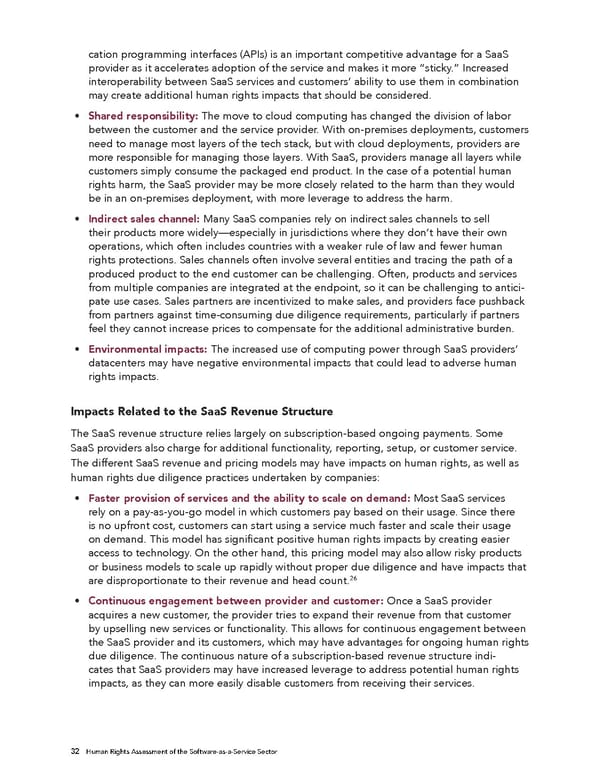cation programming interfaces (APIs) is an important competitive advantage for a SaaS provider as it accelerates adoption of the service and makes it more “sticky.” Increased interoperability between SaaS services and customers’ ability to use them in combination may create additional human rights impacts that should be considered. • Shared responsibility: The move to cloud computing has changed the division of labor between the customer and the service provider. With on-premises deployments, customers need to manage most layers of the tech stack, but with cloud deployments, providers are more responsible for managing those layers. With SaaS, providers manage all layers while customers simply consume the packaged end product. In the case of a potential human rights harm, the SaaS provider may be more closely related to the harm than they would be in an on-premises deployment, with more leverage to address the harm. • Indirect sales channel: Many SaaS companies rely on indirect sales channels to sell their products more widely—especially in jurisdictions where they don’t have their own operations, which often includes countries with a weaker rule of law and fewer human rights protections. Sales channels often involve several entities and tracing the path of a produced product to the end customer can be challenging. Often, products and services from multiple companies are integrated at the endpoint, so it can be challenging to antici- pate use cases. Sales partners are incentivized to make sales, and providers face pushback from partners against time-consuming due diligence requirements, particularly if partners feel they cannot increase prices to compensate for the additional administrative burden. • Environmental impacts: The increased use of computing power through SaaS providers’ datacenters may have negative environmental impacts that could lead to adverse human rights impacts. Impacts Related to the SaaS Revenue Structure The SaaS revenue structure relies largely on subscription-based ongoing payments. Some SaaS providers also charge for additional functionality, reporting, setup, or customer service. The different SaaS revenue and pricing models may have impacts on human rights, as well as human rights due diligence practices undertaken by companies: • Faster provision of services and the ability to scale on demand: Most SaaS services rely on a pay-as-you-go model in which customers pay based on their usage. Since there is no upfront cost, customers can start using a service much faster and scale their usage on demand. This model has significant positive human rights impacts by creating easier access to technology. On the other hand, this pricing model may also allow risky products or business models to scale up rapidly without proper due diligence and have impacts that 26 are disproportionate to their revenue and head count. • Continuous engagement between provider and customer: Once a SaaS provider acquires a new customer, the provider tries to expand their revenue from that customer by upselling new services or functionality. This allows for continuous engagement between the SaaS provider and its customers, which may have advantages for ongoing human rights due diligence. The continuous nature of a subscription-based revenue structure indi- cates that SaaS providers may have increased leverage to address potential human rights impacts, as they can more easily disable customers from receiving their services. 32 Human Rights Assessment of the Software-as-a-Service Sector
 Human Rights Assessment of the Software-as-a-Service Sector Page 32 Page 34
Human Rights Assessment of the Software-as-a-Service Sector Page 32 Page 34